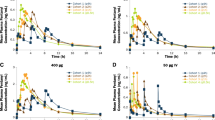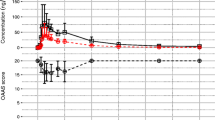Abstract
Background
The fentanyl buccal tablet (FBT) is designed to enhance the rate and extent of fentanyl absorption through the buccal mucosa.
Aim
To evaluate the bioequivalence of μg-equivalent doses of FBT administered as single and multiple tablets and assess differences in the arterial and venous pharmacokinetics of FBT in healthy volunteers.
Methods
Twenty-seven healthy adults, aged 19–5 years, participated in the randomised, open-label, three-period, crossover study. In the first two periods, FBT was administered as four 100μg tablets simultaneously or one FBT 400μg to assess bioequivalence. Venous blood samples were obtained over a 72-hour period to measure plasma fentanyl concentrations. In the third period, arterial and venous blood samples were obtained simultaneously from before administration of one FBT 400μg through 4 hours after administration to evaluate the impact of arterial versus venous sampling on the pharmacokinetic profile. As subjects were not opioid tolerant, naltrexone was administered to block opioid receptor-mediated effects of fentanyl. Adverse events were recorded throughout.
Results
Maximum plasma concentration (Cmax) and area under the plasma concentration-time curve from time zero to infinity (AUC∞) on average were approximately 12% and 13% higher, respectively, for FBT administered as four 100μg tablets simultaneously compared with one FBT 400μg. Maximum plasma concentrations in the arterial circulation were approximately 60% higher and occurred 15 minutes earlier than those measured from the venous circulation. No serious adverse events were reported during the study.
Conclusion
Despite small differences in Cmax and AUC∞ (on average 12% and 13%, respectively), FBT administered as four 100μg tablets simultaneously compared with one 400μg tablet did not meet the criteria for bioequivalence. An increased surface area exposure with four tablets compared with one tablet may account for the slightly higher maximum concentrations observed with four 100μg tablets. A substantially higher Cmax was reached earlier in the arterial than in the venous circulation.





Similar content being viewed by others
Notes
The use of trade names is for product identification purposes only and does not imply endorsement.
References
Bennett D, Burton A, Fishman S, et al. Consensus panel recommendations for the assessment and management of breakthrough pain. Part 2: management. Pharm Ther 2005; 30(6): 354–61
Pather SI, Siebert JM, Hontz J, et al. Enhanced buccal delivery of fentanyl using the OraVescent drug delivery system. Drug Deliv Tech 2001; 1(1): 54–7
Eichman JD, Robinson JR. Mechanistic studies on effervescent-induced permeability enhancement. Pharm Res 1998; 15(6): 925–30
Eichman JD, Yassin AEB, Robinson JR. The influence of in-vivo carbonation on GI physiological processes and drug permeability. Eur J Pharm Biopharm 1997; 44: 33–8
Durfee S, Messina J, Khankari RK. Fentanyl effervescent buccal tablets: enhanced buccal absorption. Am J Drug Deliv 2006; 4(1): 1–5
Hudson RJ, Thomson IR, Cannon JE, et al. Pharmacokinetics of fentanyl in patients undergoing abdominal aortic surgery. Anesthesiology 1986; 64(3): 334–8
Hug Jr CC, Murphy MR. Tissue redistribution of fentanyl and termination of its effects in rats. Anesthesiology 1981; 55(4): 369–75
Boer F, Bovill JG, Burm AG, et al. Uptake of sufentanil, alfentanil and morphine in the lungs of patients about to undergo coronary artery surgery. Br J Anaesth 1992; 68(4): 370–5
Chiou WL. The phenomenon and rationale of marked dependence of drug concentration on blood sampling site. Implications in pharmacokinetics, pharmacodynamics, toxicology and therapeutics (Part I). Clin Pharmacokinet 1989; 17(3): 175–99
Hill HF, Chapman CR, Saeger LS, et al. Steady-state infusions of opioids in human: II. Concentration-effect relationships and therapeutic margins. Pain 1990; 43(1): 69–79
Acknowledgements
This study was supported by Cephalon, Inc. (Frazer, PA, USA). The authors are employed by the sponsoring company and have no other financial interests or conflicts of interest to disclose. The authors would also like to thank James C. Kisicki, MD and the staff at MDS Pharma Services (Lincoln, NE, USA) for help in carrying out this study.
Author information
Authors and Affiliations
Corresponding author
Rights and permissions
About this article
Cite this article
Danvish, M., Kirby, M., Robertson, P. et al. Comparison of Equivalent Doses of Fentanyl Buccal Tablets and Arteriovenous Differences in Fentanyl Pharmacokinetics. Clin Pharmacokinet 45, 843–850 (2006). https://doi.org/10.2165/00003088-200645080-00006
Published:
Issue Date:
DOI: https://doi.org/10.2165/00003088-200645080-00006




